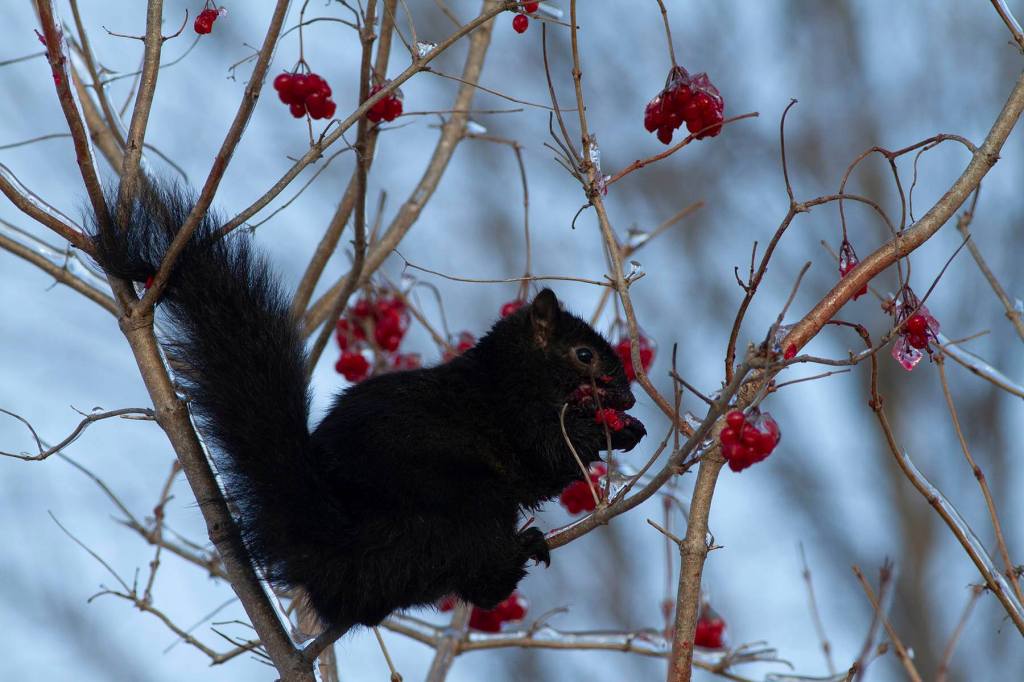
Photo by: Ann Brokelman
Species: Eastern Grey Squirrel
Scientific name: Sciurus carolinensis
Status: common
Description: Although called eastern grey squirrels, these mammals come in a few colour phases. The typical phases are black, grey and brindle. There are also white squirrels, like those found in Trinity Bellwoods in Toronto. The black phase is most dominant in Ontario and becomes less common as you move south, with no black phase being found in the Southern US. The grey phase looks salt and pepper in colour, the black phase tends to be more sleek/glossy and black. The brindle phase has more of a reddish tint to the tips of their hair, with the rest of the hair shaft appearing black. Squirrels have thick fur, which is longer in cold climates during the winter. They also have large bushy tails, which helps them with jumping (like a rudder), keeps them warm in the winter, is used to signal to other squirrels, and helps with balance on thin wires.
Habitat: Eastern grey squirrels can be found in all types of habitats from forest to city parks. They have adapted well to live alongside humans. Most of their lives are spent in the trees, but will come to the ground to search for food and to store food for eating later. Squirrels are most active during daylight hours, and are not hibernators, and can be found midday in the winter looking for food. This species of squirrel is also quite gregarious, showing little aggression towards conspecifics or other species.
Breeding: The eastern grey squirrel has two breeding seasons. One late winter (Jan-Feb), and one early summer (Jun-Jul). In the wildlife rehabilitation world, we call them summer and fall babies. The females over 2 years old will be the ones who are able to breed and are the sole provider for the young. Gestation takes 40-44 days, with litter sizes ranging from 1-6. Females will create nests made of leaves, which can be seen in trees, or will use cavities full of leaves for their breeding dens. Leaf nests are lodged in the crotch of trees, usually quite high up, and are made of twigs, leaves, moss, bark, paper or cloth, vegetation, and mom’s fur. Newborns are born blind and naked, and mature quickly. At four weeks of age their ears open and a week later their eyes open. At 8 weeks of age they can be seen venturing out of the nest and are weaning off of moms milk. By the time the young are 12 weeks old, they will be almost adult size and are totally independent of their mother. The average lifespan of eastern grey squirrels is around 6 years of age, although they have been found to live 15-20 years in captivity.
Diet: Eastern grey squirrels are opportunistic eaters. Their diet will vary with season. In the spring they will eat the buds of hardwood trees. In the summer they shift to the seeds of maple and elm, along with fruits/berries, seeds, nuts and apples. When fall comes, they will start to increase their nut intake. Eating acorns, hickory, and walnuts, to name a few. Throughout the seasons they are constantly caching food, which is what they will use to survive the winter. They can bury hundreds of nuts and seeds. Although great at burying food, they aren’t so great at remembering where they buried it. Thankfully, they use their amazing sense of smell to find buried food, and aren’t possessive of their cache, so it’s a free for all. In the winter time, they will also take advantage of all the bird feeders that humans put out.
Threats to species: The eastern grey squirrel is a common food item for many predatory animals including mink, weasel, red fox, and hawks. The young are often predated by raccoons and snakes. Additionally, non native threats come from dogs, cats and humans.
Threat to humans: Squirrels are not a threat to humans, however they are often considered a nuisance. Eastern grey squirrels will commonly nest in attics of houses. They will also dig up lawns and flower bulbs, and are relentless at bird feeders. Checking your roof for weak spots and getting squirrel proof bird feeders are two ways you can coexist with these critters.
Fun facts:
Squirrels can lose their tail sheath and some vertebrae to escape predators. That is why it is common to see eastern grey squirrels with partial tails.
When cached food is not found, it will germinate.
Humans are often entertained by squirrels and you can even buy little picnic benches for them to eat off of.
One of the ways to determine a baby squirrel is orphaned is they become “pant tuggers”. They will run up to humans and climb their pants in desperation of a parent. These guys are also often covered in fleas.
From personal experience, I can tell you squirrel bites are one of the worst bites out of all wildlife. Just trust me :s
Sources:
Hinterland Who’s Who- https://www.hww.ca/en/wildlife/mammals/eastern-grey-squirrel.html#sid2
Eder, Tamara, and Kennedy, Gregory. 2011. Mammals of Canada. Lorne Pine Publishing. Edmonton, Alberta.
